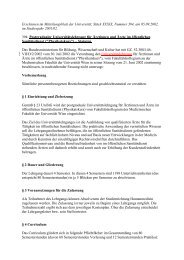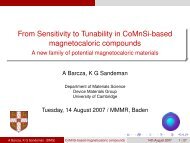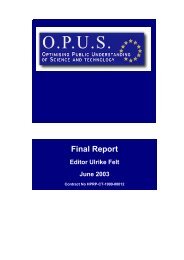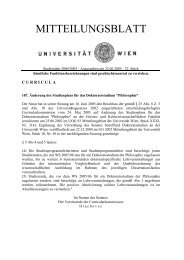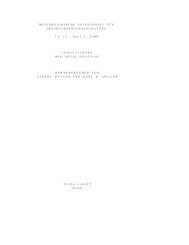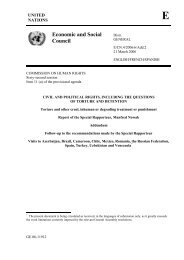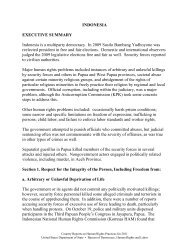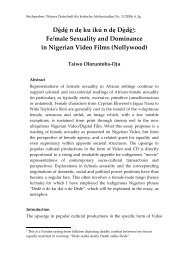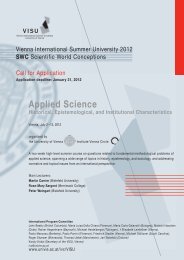(Stand: 25. Juli 2007) ANDERSON, Michael Alan ... - Universität Wien
(Stand: 25. Juli 2007) ANDERSON, Michael Alan ... - Universität Wien
(Stand: 25. Juli 2007) ANDERSON, Michael Alan ... - Universität Wien
Create successful ePaper yourself
Turn your PDF publications into a flip-book with our unique Google optimized e-Paper software.
MEDIEVAL & RENAISSANCE MUSIC CONFERENCE <strong>2007</strong> – WIEN, 7.-11. AUGUST ABSTRACTS<br />
SMITH, Anne (Schola Cantorum Basiliensis)<br />
The Rhetoric of Counterpoint<br />
Donnerstag/Thursday, 9.8., 10.15 Uhr, MuWi, HS 1<br />
As part of the humanist movement the antique sources on rhetoric were rediscovered and<br />
became part of the gentleperson’s basic education. There is always a double thrust to<br />
rhetoric: it is concerned with constructing a text with the greatest possibility of persuasion<br />
as well as with eloquent delivery. Already by the middle of the 16 th century theorists were<br />
beginning to compare the performance of a piece of music with an oration, as most clearly<br />
demonstrated by Nicola Vicentino in his L’antica musica ridotta alla moderna prattica (1555).<br />
And Gallus Dressler in his Praecepta musica of 1563 was one of the first to compare the<br />
structure of a musical piece with that of an oration, seeking thereby to achieve an ultimate<br />
expression of the affect of the text. Burmeister in his Musica Poetica of 1606 compiled a list<br />
of rhetorical figures for music, the majority of which were contrapuntal devices. In order<br />
to demonstrate how these might be used, he made a cursory analysis of Lasso’s In me transierunt<br />
irae tuae. Based on his work, this paper will present a complete analysis of the work,<br />
demonstrating how the contrapuntal and other figures were used – in conjunction with<br />
other structural and modal devices commonly referred to by theorists of the time – to express<br />
the text persuasively. Such an understanding of the inherent underlying structure of<br />
a piece, of what was meant by the choice of rhetorical (contrapuntal) figures, is a prerequisite<br />
for its eloquent, moving performance.<br />
� �<br />
SMITH, Jeremy (Departmen of Music, University of Colorado, Boulder)<br />
„A Parable in Many Men’s Opinion“: Mary Queen of Scots as Susanna in Counter-<br />
Reformation Music Propaganda<br />
Samstag/Saturday, 11.8., 9.45 Uhr, KuGe, SR 1<br />
This paper will demonstrate that the biblical story of Susanna was employed by champions<br />
of Mary Queen of Scots as a propaganda tool, in portraiture, political tracts, and especially<br />
music. Though Mary’s story has been much studied and expounded, the connection<br />
with the Susanna theme has surprisingly been overlooked.<br />
The most prominent piece of propaganda to introduce this theme was an extensive<br />
polemical tract by John Lesley, Bishop of Ross. Following upon missions that took him<br />
from London to the Netherlands, Rome, Prague, Munich, Regensburg, and Paris, Lesley<br />
settled in Rouen where he coordinated an international conspiracy on Mary’s behalf. In<br />
remarkably parallel fashion, there appeared publications and compositions on the Susanna<br />
theme by Ferrabosco, Faignient, Palestrina, Lassus, de Monte, and especially the celebrated<br />
English composer, William Byrd. Byrd wrote two settings of the Susanna story to<br />
commemorate Mary’s martyrdom in close coordination with international efforts to do<br />
likewise. In 1603, James I, her son, came to the throne of England and initiated a campaign<br />
to vindicate his mother’s honor. The Susanna theme thus emerged once again.<br />
The evidentiary base of the political framework surrounding the outpouring of<br />
Susanna qua Mary music is to be found in state papers, ecclesiastical records, diplomatic<br />
documents and espionage reports that have been preserved in official documentary collec-<br />
- 69 -




